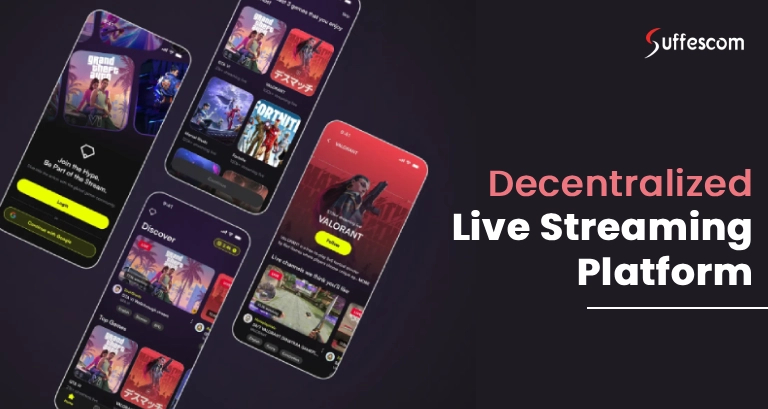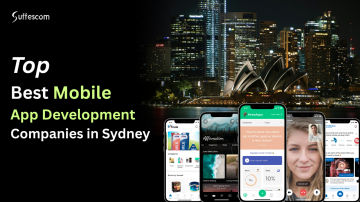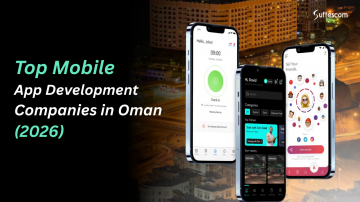Decentralized Live Streaming Platform Development: Cost, Process, and Trends in 2026

With global live streaming expected to surpass $76.86 billion in 2025 and projected to grow even further by 2030, this explosive demand highlights an urgent need for innovation in how video is created, shared, and monetized.
At Suffescom, we build that innovation. Our decentralized-based video streaming platform development services help you tap into this growth by delivering a scalable video streaming on blockchain solution. Whether you're exploring a decentralized streaming app or a full-featured decentralized live streaming ecosystem, we guide you from ideation to launch.
What Is Decentralized Live Streaming Platform Development?
A decentralized live streaming platform integrates decentralized technology with real-time video streaming infrastructure. Apart from conventional streaming apps (such as YouTube, Twitch, or Kick) that host and manage all content on centralized servers, a decentralized-based streaming app shares control among blockchain nodes. This guarantees data ownership, censorship-resistance, and direct remuneration for creators.
It's a Web3 streaming environment where live streamers can stream live, engage with the audience directly, and receive instant compensation in the form of crypto payments or NFTs, without third-party involvement.
Start Your Decentralized Live Streaming Platform Development
Build a scalable, decentralized video streaming solution with Suffescom and enter the next era of content ownership.
Standout Features of a Decentralized Video Streaming Solution
Creating a decentralized video streaming solution involves integrating decentralized architecture, blockchain transparency, and user ownership into a single, seamless experience. The following are the main features that distinguish decentralized streaming apps from classical platforms.
1. Peer-to-Peer Content Distribution
Unlike centralized servers, a decentralized streaming app uses peer-to-peer (P2P) content sharing, with data spread across multiple blockchain nodes.
This provides faster video delivery, less downtime, and zero reliance on a single provider. Users can stream content from other users in real time, making it a robust, censorship-resistant streaming network within decentralized live streaming.
2. Tokenized Monetization & Rewards
In a video streaming platform on a decentralized platform, creators and audience members get paid through a tokenized reward system. Smart contracts automatically distribute revenue in native tokens or cryptocurrencies, with equitable pay for attention and content quality.
This blockchain model reshapes digital monetization, empowering creators with greater control while enabling platforms to build a viable, community-supported economy.
3. Smart Contract Subscriptions
Traditional subscription models typically involve intermediaries and manual billing. Smart contract–based subscription models, on the other hand, have everything occur openly on-chain.
Users can subscribe to premium content or channels through automated, self-enforcing contracts that improve trust, minimise fraud, and enable transparent payment distribution in any decentralized video streaming solution.
4. Secure & Immutable Video Storage
Security is the foundation of any decentralized video hosting platform. By employing blockchain and decentralized file storage (such as IPFS or Filecoin), videos are stored in a non-mutable, tamper-evident environment.
This safeguards creators from content loss, censorship, or unauthorized usage while ensuring smooth video streaming on blockchain infrastructure.
5. Community-Governed Platform Control
A genuine decentralized live streaming platform is all about community ownership. Governance tokens give users the power to vote on updates, policies, and monetization strategies for the platform, maintaining transparency and decentralization.
Community-based governance offers each stakeholder, from creators to viewers, a genuine voice in how the platform develops, differentiating it from centralized streaming networks.
Decentralized vs Centralized Streaming Platforms – A Comparative Overview
The global shift toward decentralization is changing how video content is created, stored, and shared. Traditional platforms such as YouTube or Twitch operate on centralized architectures that give control to a single entity. While decentralized live streaming platforms distribute power among users, creators, and nodes on the blockchain.
Comparison Table: Decentralized-Based vs Centralized Streaming Platforms
| Aspect | Decentralized-Based Streaming Platform | Centralized Streaming Platform |
| Ownership & Control | Full ownership rests with creators and users. No single entity governs the content or data. | Controlled by platform operators who decide monetization rules, visibility, and censorship. |
| Transparency | Powered by blockchain, every transaction and interaction is publicly verifiable. | Limited transparency. Revenue sharing, algorithms, and ad metrics are managed privately. |
| Revenue Models | Tokenized monetization enables direct, peer-to-peer rewards for creators and viewers. | Revenue primarily comes from ads, with creators getting a smaller share of platform profits. |
| Security & Privacy | Uses encryption and decentralized storage to secure user data and prevent tampering. | Data stored on centralized servers, making it vulnerable to hacks, leaks, or misuse. |
| Data Ownership | Users and creators maintain full control over their videos and metadata via blockchain. | Platform retains ownership and can remove or restrict access at any time. |
| Censorship Resistance | Immutable records on blockchain prevent arbitrary content removal. | Subject to censorship, policy changes, and content takedowns. |
| Scalability & Performance | Leveraging distributed nodes improves performance, reduces downtime, and scales globally. | Performance depends on data center capacity; may face congestion or regional restrictions. |
| Cost Efficiency | Peer-to-peer architecture and smart contracts lower operational costs and intermediaries. | High operational expenses due to server maintenance, bandwidth, and centralized infrastructure. |
| Revenue Distribution | Automated via smart contracts, ensuring transparent and fair payouts. | Controlled by the platform, often resulting in delayed or uneven payments. |
| User Engagement | Enhanced with community governance, NFTs, and tokenized loyalty programs. | Engagement limited to likes, comments, and traditional ad-driven incentives. |
| Governance Model | Community-driven; users vote on features, rules, and revenue sharing. | Platform-driven; decisions made by corporate management or investors. |
| Global Accessibility | Decentralized networks allow unrestricted global access. | Geo-blocks or regulatory limits may restrict users from certain regions. |
Unmatched Advantages of Decentralized Video Sharing and Streaming Platforms
By opting for decentralized live streaming platform development, brands gain access to a censorship-resistant, secure, and community-governed video ecosystem.
1. No Central Node of Failure
A decentralized video hosting network removes the threat of total system shutdowns. As data is shared across several nodes, the platform remains operational even when a node fails. It is making decentralized streaming applications much more reliable and robust compared to central systems.
2. Copyright Protection and Immutable Ownership
In a blockchain video-sharing platform, each video uploaded is time-stamped and kept on an immutable public ledger. This enables transparent ownership records, protecting creators from copyright infringement or unauthorized duplication of their content.
3. Smart Contract Automation
Smart contracts automate payments, royalties, and content access on a decentralized streaming platform. They implement pre-defined contracts instantly without intermediaries. It minimizes human error and ensures transparent and accurate transactions.
4. Fair Revenue Distribution for Creators
Unlike conventional streaming sites that charge high commission fees, decentralized video streaming platforms give creators a direct cut. Tokenized payment systems facilitate instant peer-to-peer transfers with equitable earnings and greater transparency.
5. Greater Security and Privacy
Both user information and content streams are protected by blockchain encryption. Web3 streaming applications shield against hacks, data leaks, and censorship, granting users full control over their content and viewing history.
6. Global Accessibility
Decentralized streaming eliminates geographical barriers, allowing creators to access international audiences without reliance on centralized hosting servers. It creates a boundaryless entertainment environment.
7. Efficient and Scalable Infrastructure
As decentralized video streaming is based on peer-to-peer sharing of data, the cost of infrastructure and bandwidth is substantially lowered. Decentralized video streaming scales naturally with user expansion, which is perfect for next-generation streaming entrepreneurs.
8. Community Governance and Transparency
Most blockchain streaming sites adhere to DAO (Decentralized Autonomous Organization) models, in which users and creators can vote on platform upgrades, token policies, and content moderation rules.
Build Your Decentralized-Based Video Streaming Platform Smarter
Decentralized apps deliver up to 40% higher ROI than traditional models. Build your decentralized streaming platform with Suffescom.
Real-World Use Cases for Decentralized Live Streaming Platforms
These use cases showcase the limitless potential of blockchain in shaping the future of interactive, user-owned media.
1. Creator Economy & Independent Content Production
Build a censorship-resistant platform where independent journalists, educators, and artists stream without fear of demonetization or takedowns.
2. Gaming & Esports Streaming
Launch decentralized gaming platforms where streamers earn tokens directly from viewers, with NFT-based achievements and community tournaments.
3. Live Events & Concerts
Host ticketed virtual concerts, conferences, or workshops with blockchain-verified access and NFT memorabilia for attendees.
4. Educational Content & Online Learning
Create decentralized e-learning platforms where instructors receive fair compensation and students own their certificates as NFTs.
5. Enterprise & Corporate Communications
Build secure, private streaming networks for internal company broadcasts, training sessions, and stakeholder meetings.
6. Adult Content & Niche Communities
Provide uncensored platforms for creators in restricted industries, ensuring payment processing and content ownership.
7. Social Impact & Citizen Journalism
Enable activists and citizen journalists to broadcast without censorship, maintaining transparency through blockchain records.
8. Sports Broadcasting & Fan Engagement
Develop fan-owned sports streaming platforms with token-based voting for content decisions and exclusive access rights.
The Development Process for a Decentralized Streaming App
Our decentralized-based video streaming platform development process starts with blockchain selection, followed by smart contract and wallet integration.
1. Ideation and Technical Planning
Defining the project scope, feature set, and business goals to align with decentralized streaming app development objectives.
2. Choosing the Right Blockchain (Ethereum, Polygon, Solana, etc.)
Selecting a blockchain network based on scalability, transaction speed, and cost-efficiency for your decentralized video streaming platform.
3. Smart Contract Architecture
Developing smart contracts for subscriptions, token rewards, and integrating crypto wallets for seamless Web3 transactions.
4. UI/UX Development
A seamless UI/UX is vital to Web3 Streaming Platform Development, ensuring that decentralized functionality doesn’t compromise ease of use or streaming quality.
5. Testing, Deployment, and Post-Launch Support
Conducting rigorous QA testing before mainnet deployment and ensuring continuous updates and maintenance post-launch.
6. Tokenomics and Monetization Strategy Design
Creating a robust token economy that supports creator rewards, staking mechanisms, and viewer engagement within the decentralized ecosystem.
Estimating the Cost to Develop a Decentralized Streaming Platform
The cost to develop a decentralized streaming platform ranges from $30,000 to $50,000, depending on the scope of your project, selected blockchain, and features. The more advanced your app architecture, such as incorporating smart contracts, token-based subscriptions, or real-time chat, the bigger the investment.
Projects developed in a decentralized live streaming platform typically demand extra resources to implement security audits, wallet integration, and scalability on-chain. But through efficient planning and modular construction, you can reduce time and cost while preserving performance.
To maximize your budget, start with an MVP that includes core features such as content upload, user dashboards, and wallet integration. Expand later with premium features like AI recommendations or DAO-based governance.
Proven Tech Stack Behind High-Performance Decentralized Streaming Platform Development
The tech stack we use for decentralized-based video streaming platform development combines blockchain, IPFS, and real-time streaming protocols.
| Component | Technologies / Tools | Purpose / Function |
| Blockchain Layer | Ethereum, Polygon, Solana, Avalanche | Powers smart contracts, transactions, and subscriptions for video streaming on blockchain |
| Decentralized Storage | IPFS, Arweave, Filecoin | Provides immutable, censorship-resistant video storage |
| Smart Contracts & Wallets | Solidity, Rust, Web3.js, MetaMask, WalletConnect | Handles on-chain payments, subscriptions, and user authentication |
| Frontend Technologies | React.js, Next.js, Vue.js | Builds fast, responsive, and interactive interfaces for users |
| Backend Frameworks | Node.js, Go, Python | Manages APIs, streaming logic, and content distribution |
| Streaming Protocols | HLS, WebRTC, Livepeer, Theta | Enables real-time, decentralized video streaming within the decentralized live streaming ecosystem |
| Database & Indexing | MongoDB, PostgreSQL, The Graph | Stores metadata and manages on-chain query indexing efficiently |
Seamless Integrations for Your Decentralized Streaming Ecosystem
With these integrations, your decentralized streaming platform becomes smarter, faster, and fully ready for Web3 scalability.
1. Payment Gateways & Crypto Wallets
- MetaMask, WalletConnect, Coinbase Wallet
- Stripe Crypto, Transak, MoonPay (fiat on-ramps)
- Multi-currency support (ETH, SOL, MATIC, USDT, USDC)
2. Social & Community Features
- Discord integration for community management
- Twitter/X API for social sharing
- Telegram bots for notifications and alerts
- Reddit integration for discussions
3. Analytics & Monitoring
- The Graph for blockchain data indexing
- Google Analytics, Mixpanel for user behavior
- Dune Analytics for on-chain metrics
- Custom dashboards for creator insights
4. Content Delivery Networks (CDN)
- Livepeer for decentralized video transcoding
- Theta Network for P2P streaming
- Cloudflare for hybrid CDN support
- IPFS gateways for content distribution
5. Third-Party Services
- Chainlink oracles for real-time data feeds
- Push Protocol for Web3 notifications
- Lens Protocol for social graph integration
- NFT marketplaces (OpenSea, Rarible) integration
Launch Your Decentralized Streaming App Today
Partner with Suffescom, a leading decentralized exchange development company, to build your decentralized video streaming solution with ease.
Proven Monetization Strategies for Decentralized-Based Video Streaming Platforms
One of the greatest strengths of a decentralized video-sharing website is its creator-oriented monetization framework. While centralized streaming websites charge creators high commissions or cap payments, decentralized-built video streaming sites give power back to the creators with open, smart contracts. Below are some of the most successful mechanisms through which creators can be rewarded:
1. Token Tipping
Audiences are able to send immediate crypto tips or micro-payments to the content creators they prefer. These transactions get posted directly onto the blockchain,providing full transparency and no platform charge.
2. Subscription Models
Content creators can provide premium, exclusive content via smart contract-enabled subscriptions. Automatic payment systems ensure access and renewals occur without intermediaries.
3. Affiliate and Brand Partnerships
Web3 streaming provides an opportunity for blockchain-native sponsorships and affiliate promotions. Creators can engage with NFT brands, decentralized initiatives, or token releases for win-win promotions.
4. Digital Merchandise & NFTs
Tokenize your work using NFT-based videos, collectibles, or branded digital products. It enables fans to buy, trade, or collect your exclusive drops while proving your ownership verifiably on the blockchain.
5. Paid Channel Memberships
Create a loyal following with a tiered membership that offers additional benefits such as private sessions, Q&A access, and behind-the-scenes content. It establishes a consistent and recurring revenue stream.
Key Trends Shaping Decentralized Live Streaming Platform Development in 2026
These trends mark a turning point for digital creators and viewers alike, redefining how content is streamed, owned, and rewarded in the decentralized era.
- AI-driven video recommendations and real-time content moderation.
- Growth of decentralized CDN and peer-to-peer streaming infrastructure.
- Multi-chain interoperability for seamless cross-network transactions.
- NFT-based content ownership and creator monetization models.
- Integration of AR/VR for immersive streaming experiences.
- Enhanced token reward systems and community-driven governance.
- Simplified wallet integration and gasless transactions for users.
- Rising adoption of Web3 social and creator-centric streaming apps.
- Focus on privacy-first, censorship-resistant content delivery.
- Expansion of DAO-based platforms for decentralized content control.
Partner with Suffescom to Build a Next-Gen Decentralized Video Streaming Platform
As a leading decentralized exchange development company, we help you launch a future-ready decentralized video platform that stands out in the Web3 ecosystem. Suffescom stands among the top companies in Web3 Streaming Platform Development, delivering custom and white-label solutions tailored to your business model.
1. Decentralized Streaming Expertise
We empower brands to launch decentralized video streaming platforms that promote transparency, creator control, and fair monetization.
2. Blockchain-First Approach
Our team leverages blockchain technology to build secure, scalable, and blockchain-based video platforms that transform how digital content is shared and rewarded.
3. Skilled Decentralized Developers
With experienced decentralized live streaming platform developers, we ensure flawless integration of smart contracts, token rewards, and crypto wallets into your ecosystem.
4. Custom-Built Solutions
Every project is tailored to your business goals, audience needs, and platform vision, from feature design to tokenomics and streaming logic.
5. Full-Cycle Development
We handle everything, from planning and architecture to deployment, testing, and ongoing platform support. It ensures a smooth and reliable experience.
6. Long-Term Partnership & Support
Beyond development, we provide continuous optimization, tech upgrades, and maintenance to keep your decentralized streaming ecosystem performing at its peak.
FAQs
1. Why is a decentralized live streaming platform not YouTube or Twitch?
Unlike YouTube or Twitch, a decentralized live streaming platform is blockchain-based, so there is no single firm with control over your data or revenue. Creators own their videos completely, and all payments or rewards are processed via smart contracts, making the system just, transparent, and censorship-free.
2. How will a decentralized video hosting platform help my business?
A decentralized video streaming platform provides increased transparency, lower operational expenses, and greater authority over how the content is dispensed and monetized. As it is based on blockchain technology, it secures data, does away with third-party interference, and allows your users to reach directly to creators with crypto-based payments.
3. What are the costs involved in developing a decentralized streaming platform?
The price of building a decentralized streaming platform typically ranges from $20,000 to $30,000. Price varies based on your feature set, blockchain of choice (such as Ethereum or Polygon), and whether you add advanced features such as NFTs, tokenized tipping, or DAO-based governance.
4. Can I have my own branded decentralized video streaming solution?
Yes, absolutely! Our team at Suffescom can build a custom decentralized video streaming solution tailored to your brand’s vision. From interface design to tokenomics and user engagement tools, everything is customizable, whether you’re building a niche content hub or a large-scale Web3 streaming platform.
5. How secure is video streaming on blockchain?
Blockchain video streaming employs decentralized storage networks such as IPFS or Filecoin, which ensures your content is tamper-proof and censorship-resistant. Each video is encrypted and distributed across multiple nodes so that no individual, not even the platform owner, can edit or remove it without user permission.
6. Why should I hire Suffescom for my decentralized streaming app development?
Suffescom is a leading decentralized exchange development firm with strong experience in blockchain and Web3 innovation. Our experienced decentralized live streaming platform programmers create platforms that are secure, fast, and scalable to enable you to generate new revenue streams while leading the way in decentralized media.
7. What blockchain is best for a decentralized streaming platform?
The ideal blockchain depends on your priorities:
1. Ethereum: Most established, largest developer community, but higher gas fees
2. Polygon: Ethereum-compatible with lower costs and faster transactions
3. Solana: Ultra-fast, low-cost transactions, ideal for microtransactions and tipping
4. Avalanche: High throughput, subnets for custom rules
5. BNB Chain: Lower fees, good for emerging markets
Our team at Suffescom analyzes your target audience, transaction volume, and budget to recommend the optimal blockchain for your decentralized streaming platform.
8. How long does it take to develop a decentralized streaming platform?
Development timeline typically ranges from 3 to 9 months, depending on complexity:
- MVP (Basic features): 3-4 months
- Full-featured platform: 6-7 months
- Enterprise-grade with advanced features: 8-9+








